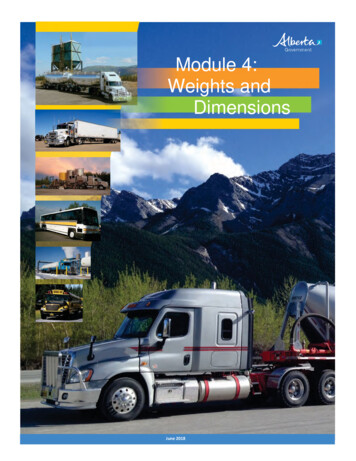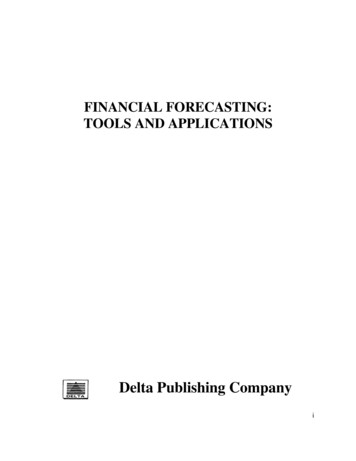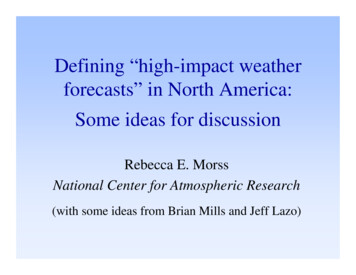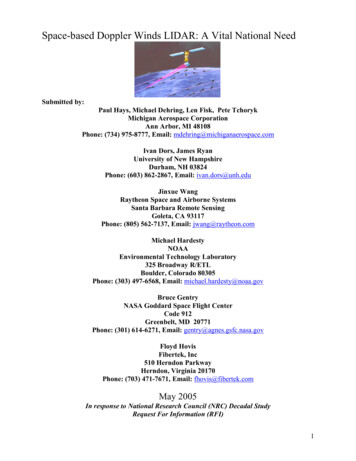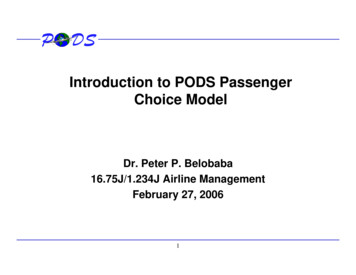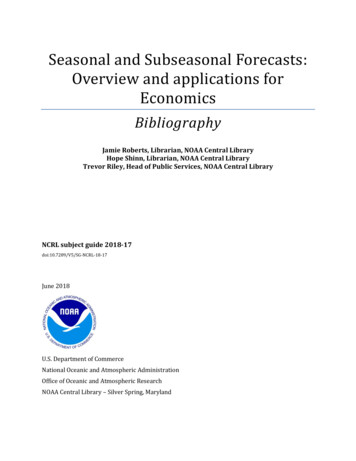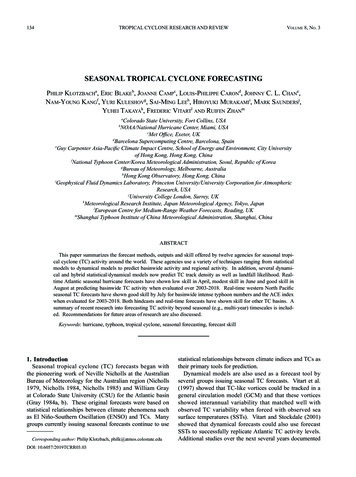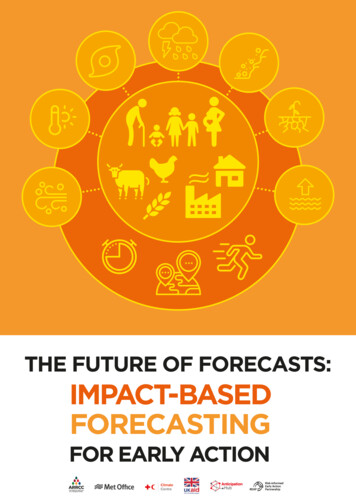
Transcription
THE FUTURE OF FORECASTS:IMPACT-BASEDFORECASTINGFOR EARLY ACTION
THE FUTURE OF FORECASTS:IMPACT-BASEDFORECASTINGFOR EARLY ACTION
FOREWORDSWE OFTEN TALK about the desire to go the ‘last mile’ and narrow the gap betweenscience and action. It was this desire that provided the catalyst for a change to impactbased thinking.The core tenet of this paradigm shift was to bring differing communities together, toprovide the mechanisms and collective desire to make a difference on the ground,to save lives, and to reduce distress and disruption. That was the idea, and it worked.The most valuable part of impact-based warning is the relationship between partners,which creates a level of trust that enables quick decision-making under pressure. Thisis both a strength and a weakness, as any gap in these relationships could dramaticallyreduce the overall impact of the warnings.It also suggests that citizens’ trust may be dependent on who delivers the informationand what relationship they have with the user. Maya Angelou is quoted as sayingthat ‘People forget what you say, forget what you did, but not how you made them feel’.The question is ‘how do others feel?’ when they engage with the provider of impactbased forecasts, and how do we allow others to resonate with us so they feelempowered and enriched from the experience?Our warnings often focus on single hazards and their direct consequences. Peopleliving in well-built homes, in urban settlements, generally have little to fear fromthe direct impacts of most hazards (except perhaps floods). However, urbanpopulations, particularly coastal megacities, can be extremely vulnerable to indirectimpacts such as the loss of power, water, communications, transport and even food.All this at a time of great environmental and societal change. The next frontier couldbe unlocked through the science of weather and climate or, equally, through embracingnew technologies (data analytics and artificial intelligence), and developing thecognitive intelligence on future climates to anticipate weather impacts and informactions today.No doubt we could all become masters of our weather-impact-based decision support.We could all be meteorologists as well as doctors. However, this is also the age ofimagination.Everything you need to know you can get from Google. What you cannot get is whereknowledge ends. We need partnerships which do not follow straight lines but whocan navigate freely; creativity not knowledge; imagination rather than intelligence.As the climate changes, our vulnerability to it and therefore our behaviour ischanging, and we need to embrace this change and move away from disciplinary silostowards a multi-disciplinary, ecosystem model.We should endeavour to embrace emotional intelligence and empathy, entrepreneurshipand design, creativity and digital literacy. This guide is the start of that process. Itprovides the toolkit to develop and deliver impact-based forecasting and warningservices and, above all, it advocates partnerships, ambition, and the desire to makea difference. It also provides a key stepping-stone to finally going the ‘last mile’.Paul DaviesChief Meteorologist, UK Met Office4The Future of Forecasts
FOREWORDS TODAY, one weather- or climate-related disaster occurs every 1-2 days – and climatechange is only leading to more worrying trends in terms of frequency and scale.However the impacts of disasters are unequal, as the coping capacity of the peoplethey hit is based on the resources at their disposal to protect themselves fromdisasters – often most limited in areas where climate impacts like floods, droughts andstorms hit hardest. Our Red Cross and Red Crescent staff and volunteers working onthe frontline know this too well.But inequalities in front of weather- or climate-related disasters can be greatlyreduced. By using forecasts and risk analyses to determine when, where, with andfor whom to implement early action to protect lives and livelihoods. By applyingimpact-based forecasting, complex scientific information is transformed intoinformation that is actionable, enabling humanitarian interventions such as shelterstrengthening by farmers in the Philippines’ coastal region before a typhoon’s landfallor the distribution of veterinary kits to protect alpacas as source of livelihoods forfamilies in the mountainous Andean region of Peru against cold wave. Existing in192 countries as auxiliary to the government and operating from national to thecommunity level, our local Red Cross and Red Crescent branches play a key role inbridging knowledge and practice, building trust and providing timely and relevantsupport developed with and for the communities.Through the collaboration with National Hydrometeorological Services, NationalDisaster Management Agencies and other key stakeholders, National Red Cross andRed Crescent Societies in at least 30 disaster-prone countries across the globe areworking to outsmart disasters by having pre-approved plans in place to launchforecast-based early action for extreme weather events. That number is growing.In addition, this year saw the first large-scale, coordinated inter-agency triggering ofanticipatory actions by impact-based forecasts and warnings. As heavy monsoonrains hit Asia, four UN agencies and Red Cross Red Crescent partners workedalongside the Bangladesh Government to anticipate the likely impacts and releasefunds to help communities at risk ahead of a flood peak.In the spirit of co-creation and collaboration, this guide has been developed to providepractical advice and promote dialogue between scientists, forecasters, disastermanagers, community leaders and other relevant users. By expanding the use ofimpact-based forecasting, we can further strengthen our efforts to translate earlywarning into early action, saving countless lives and reducing suffering – efforts mademore urgent than ever with our changing climate.Pascale MeigeDirector, Disasters and Climate Crisis DepartmentInternational Federation of Red Cross and Red Crescent SocietiesImpact-based Forecasting for Early Action5
ContentsHow to use this guide10Chapter 1. Introduction12Chapter 2. Understanding Users16Identifying users17Analysing user needs and meeting requirements18Chapter 3. Understanding Risk and Impact20The role of impact and risk assessments in impact-based forecasting21Impact assessments: identifying hazard impacts22Risk Assessments26Defining Risk26Identifying the hazard26Vulnerability and Exposure27Identifying impact levels from hazard thresholds29Future hazards and impact levels31Chapter 4. Partnerships and collaboration32Roles and responsibilities of partner organisations34Challenges and opportunities for creating flourishing partnerships35Chapter 5. Producing Impact-based Forecasts and Warnings38Choosing a hazard - start simple39Determining the level of impact40Determining likelihood of impact40Forecast Verification41Bringing the risk assessment together41Risk Matrix642Incorporating production time and updates44Impact-based forecast and warning production software45Content of impact-based forecasts and warnings46Pilot projects46Examples of visualisation of impact-based forecasts and warnings intervention maps47The Future of Forecasts
Africa –Malaria Early Warning System47Canada – producing risk maps with the aid of machinelearning and artificial intelligence48Peru – Disaster Management Office Risk Scenarios48Mongolia – Dzud Forecast-based Financing and Risk Maps48UK - Natural Hazards Partnership Vehicle over Turning Model49Chapter 6. Communicating & Disseminating Impact-based Forecasts and Warnings52Communicating impact-based forecasts and warnings53What to communicate54Impact-based forecast and warning design55Consistency57Communicating risk58Communicating forecast and warning scenarios – what is the ‘best message’?58Communicating uncertainty59Advice and guidance for users: ‘what can I do to reduce impacts?’60Sector specific users60For individuals/members of public60Hydrometeorological jargon61Language61Channels and Technologies for Dissemination63Chapter 7. Accountability, Verification, Archive and Review66Accountability67Verification67Gathering impact information for verification70Social media monitoring tools70Surveys and Feedback71Examples of verifying impact-based forecasts and rences77Impact-based Forecasting for Early Action7
BoxesIPCC Definitions of Hazard Vulnerability and Exposure21Key Data Questions28Vietnam Forecast based Financing Project for Heatwaves35USA - Wireless Emergency Alerts (WEA)63510 Online News Scraper and Text Mining Tool70TablesTable 1. Comparisons between Traditional Forecasts, Impact-based Forecasts,and Co-produced Impact-based Forecasts 14Table 2. Potential Data Sources for Hazard Impacts 22Table 3. Examples of Disaster Impacts 24Table 4. Winter Windspeeds and Impact levels 29Table 5. Uganda Action-based Flood Forecasting Project:Organisations and Roles - Example 36Table 6. Barriers and Enablers to Forecasts and Warnings 49Table 7. User Related Questions for Impact-based Forecasting and Warning 54Table 8. Questions for Forecast Verification 68Case studies8Case study – UK Met Office Wind Warnings29Case Study – Identifying thresholds for heatwave warnings in Argentina31Case Study – The Natural Hazards Partnership (UK)37Case Study – Forecast-based Financing in the Philippines50Case Study – Developing impact-based forecasting in data sparseareas in Uganda 51Case Study – Inconsistent Forecasts and Warnings Switzerland57Case Study – Evolution in risk communication in the UK Met Officeimpact-based weather warnings 64Case study – UK Subjective Verification Form (Form as of March 2015)72The Future of Forecasts
FiguresFigure 1. IBF Stakeholder Mapping in Malawi(Malawi Red Cross/510 adapted for this guide by Climate Centre)18Figure 2. Schematic of the Interaction of the Physical Climate System, Exposure,and Vulnerability Producing Risk (IPCC, 2014)21Figure 3. Web site description of how heatwave thresholds are calculated andAdvice on what to do in a heat wave to minimise impact on human health(translated from the original Spanish)31Figure 4. Future Climate for Africa: Six Building Blocks for Co-production33Figure 5. United Nations Office for Disaster Risk Reduction: Seven Targets of theSendai Framework for Disaster Risk Reduction 2015-203034Figure 6. Organisations Involved in UK’s Natural Hazard Partnership37Figure 7. Impact-based National Hazard Outlook in Australia39Figure 8. UKMO Risk Matrix for Vehicle Overturning (Hemmingway & Robbins, 2020)42Figure 9. Red Cross Red Crescent Forecast-based Financing: Impact-basedIntervention Map for Jamuna River Basin, Bangladesh43Figure 10. Actions Selected for a Forecast-based Financing System for Floodingin Uganda44Figure 11. IRI VCAP Model - Malaria48Figure 12. Meteorological Notice - Risk Scenario according toRainfall Forecast48Figure 13. Dzud Risk Map, Mongolia49Figure 14. Evolution of the UK Met Office Amber Weather Warnings for Wind Showing49Figure 15. Predicted Percentage of Fully Damaged Houses for Typhoon Kammuriin the Philippines, Based on the Impact-based Forecasting MachineLearning Model50Figure 16. Historical Discharge Magoro51Figure 17. Font and Size for Effective Communication55Figure 18. Indonesia Warning Risk Matrix, Table of Response Actions andWarning Map for Indonesian Board of Disaster Management56Figure 19. Different Services, Different Warning Information57Figure 20. UK Met Office Storm Maps58Figure 21. UK Met Office Snow Risk Warning 59Figure 22. Perception of Information for Four Types of warnings(standard or impact-based, with or without behavioural recommendations)60Figure 23. WHO typhoon advice61Figure 24. Initial Results from the UK Met Office Language Exercises forDescriptions of Probability64Figure 25. Excerpt from a UK Met Office Impact-based Weather Warning65Figure 26. Mongolia Livestock Mortality Map70Figure 27. Australian Bureau of Meteorology - PERM Process Flowchart71Impact-based Forecasting for Early Action9
How to use this guide:This guide outlines the steps and tools needed to develop impact-based forecasting:from understanding risk to producing, issuing and verifying fit for purpose impactbased forecasts and warnings. Designed with, and for, people working in impactbased forecasting, early warning and early action, the compiled information andrecommendations will be useful for everyone from technical staff in nationalhydrological and meteorological services to disaster risk management, humanitarianand development agencies. The guide includes case studies from countries around theworld to highlight the development and use of impact-based forecasting services forusers and producers. A result of joint work between the Red Cross Red Crescent andthe UK Met Office, this document aims to inspire the co-production of impact-basedforecasting services that use weather, climate information, and risk analysis to reducerisk. The guide brings together the forecast-based financing methodology to triggerearly action with the impact-based forecasting technical expertise of the UK MetOffice and other experts in this field. Each chapter contains recommended steps andprocesses, as well as online resources for more detailed guidance.10The Future of Forecasts
Content Structure of the Guide What is IBF andwhy is IBF important?Chapter 1.Who are the users andwhat are their needs?Chapter 2.What are therisks?What are theimpacts to reduce?Chapter 3.How to develop IBF?Chapter 4-5.Whom tocollaborate with?What toconsider?What to communicate?Chapter 6.How to disseminate?Why is IBF verificationimportant?How to review andimprove IBF service?Impact-based Forecasting for Early ActionChapter 7.11
Chapter 1. IntroductionChapter 1. IntroductionCyclone Idai, Mozambique, aftermath, 15-16 March 2019(Photo: Denis Onyodi: IFRC/DRK/Climate Centre)12The Future of Forecasts
Chapter 1. IntroductionImpact-based forecasting enables anticipatory actions and revolutionises responsesto weather and climate crises: turning forecasts and warnings from descriptions ofwhat the weather will be into assessments of what the weather will be intoassessments of what the weather will do enables organisations and individuals acrossthe world to anticipate and take action to mitigate the impacts brought by weatherand climate events.Impact-basedBy developing impact-based forecasting, producers of forecasts and warnings providecritical information to help mitigate life-threatening impacts. The World FoodProgramme calculated that releasing funds to vulnerable communities andindividuals ahead of potentially devastating weather or climate events, enablesactions that save lives, livelihoods and property.Impact-basedforecasting drivesactions which savelives and protectproperty andlivelihoods.forecasting providesinformation on thelevel of risk a hazardposes to a specificarea.With ever growing pressure on land use, energy, livelihoods, availability of food,water and shelter, global interest in minimising human and economic cost ofextreme weather and climate events continues to increase. Impact-based forecastingprovides the information needed to act before disasters to minimise the socioeconomic costs of weather and climate hazards. Organisations and individuals canmake critical decisions to ensure that resources and supplies are in place to takeearly action and to respond as soon as it is safe to do so. Impact-based forecasting isone of the crucial elements of the Red Cross Red Crescent Forecast-based Financingsystems. The World Food Programme calculated that releasing funds to vulnerablecommunities and individuals ahead of potentially devastating weather or climateevents, enables actions that save lives, livelihoods, and property.Impact-basedforecasts andwarnings provide anassessment of theforecast weather orclimate hazard and anassessment of thepossible impacts,including when,where and how likelythe impacts are.The inclusion of risk assessments makes impact-based forecasting unique amongother forecasts and warnings. Hazard forecast information combined withvulnerability and exposure data is used by national hydrological andmeteorological services and partner organisations to create a risk assessment.‘We found that impact-based warnings increased thelikelihood that people would take protective action,” saysPhilippe Weyrich at the Swiss Federal Institute of Technologyin Zurich’ The Washington Post‘Crucial evidence has been gathered to showcase the costeffectiveness of early actions (triggered by impact-basedforecasts). Across four case-studies, Return-of-Investmentratios ranged from USD 2.5-7.2 for every USD 1 spent on earlyinterventions.’ Food and Agriculture Organization. GlobalDialogue Platform on FbF-Berlin 2018‘Damage, suffering and the cost of emergency aid will reducewhen communities are capable of responding proactively to adisaster through early impact-based warning and earlyaction.’ Netherlands Red Cross 510 initiative.Impact-based Forecasting for Early Action13
Chapter 1. IntroductionTable below contrasts fictional examples of traditional forecasts with impact-basedforecasts in context of flooding and tropical cyclone.Table 1. Comparisons between Traditional Forecasts, Impact-based Forecasts,and Co-produced Impact-based ForecastsHazardForecastImpact-based forecastfor Individuals/members of publicFloodingHeavy rain is forecast.Flash flooding of theThe forecast water level in the100 to 150mm of rain isCounty River is expected.recreational district is expected toexpected within aDwellings, farm buildingscross the 0.85 alert threshold inthree-hour period.and grazing land within5 days and remain above for a30m of the river channelfurther 3 days. An impact forecast ofare expected to flood andloss of household assets is over 25%be damaged.and affected population over 40%.Impact based forecast for Sectorspecific usersTropicalA tropical cycloneA tropical cycloneA Tropical cyclone, lead time ofCyclonecategory 3, windspeedcategory 3, windspeed of30 hours, with wind speed greaterof 125 km/h is expected125 km/h is expected tothan 125 km/h, corresponding toin the next 48 hours.make landfall in 12 hours,an impact forecast of damage ofin X and Y regions, likely to25% of housing.damage criticalinfrastructure such asbridges, blockingtransport fromregion X to region Y.With impact-based forecasting, national hydrological and meteorological servicesassess the impacts of the forecasted climate and weather phenomenon and considertheir warnings based on the level and severity of those impacts at that particularlocation and /or for the target users/groups.14The Future of Forecasts
Chapter 1. IntroductionMethodological Framework of Impact-based Forecasting (IBF)and Warning ServiceDeliver IBFCoproduce IBFCodesign IBFUnderstandWarnings Needs forEarly ActionsBuildPartnerships andCollaborationsAssess Risk(Hazard Vulnerability Exposure)Identify/PrioritizeImpact of interestForecast HazardDetermineLevelof ImpactRisk MatrixInterventionMapDefineLikelihood ofImpactCommunicateDisseminatePrepare and Act EarlyFlow processReview, Verify & ImproveImpact-based Forecasting for Early ActionLinkage15
Chapter 2. Understanding UsersChapter 2. Understanding UsersGerman Red Cross Integrated Climate Change Adaptation programmein Teso and Karamoja sub-regions of Uganda16(Photo: Denis Onyodi/URCS-DRK-Climate Centre)The Future of Forecasts
Chapter 2. Understanding UsersUnderstanding the users of forecasts and warnings is critical to the developmentand operational delivery of impact-based forecasting. These understandings areformed through partnerships with the individuals and organisations that will usethe final tools. From the design to the delivery of impact-based forecasts andwarning, input from users is essential.Identifying usersNational hydrological and meteorological services and partners developing impactbased forecasting must identify who will be using the forecasts and warnings.Users of forecast and warnings are found often within organisations involved indisaster risk reduction, crisis management, disaster response or any organisation,business or individual that needs to make decisions in the face of a potentiallyimpactful weather or climate event. Look for the individuals who are responsible formaking critical decisions in disaster risk reduction.Potential users of impact-based forecasts and warnings are diverse. It is not oftenpossible to develop a forecast or warning which will satisfy all of their requirements.Often users will require impact-based forecasts and warnings services be tailored tothe specific challenges they are trying to address.Typical Impact-based Forecast Users Members of the public Local businesses Community leaders Transport services Government departments (agriculture, social Energy providers and serviceswelfare, public works etc.) Local government officials Water providers and services Telecommunication providers and services Disaster Risk Reduction and Civil ProtectionAgencies: humanitarian agencies development agencies police military hospitals and health providers local disaster managersA cyclone warning would need different information to be useful to a department ofpublic works compared to a humanitarian organisation. For a department of publicworks, an impact-based forecast service might focus on the probability andmagnitude of cyclone hazards that are likely to severely damage certain types ofinfrastructure across the exposed area. A humanitarian organisation focusing onsupporting the most populations will likely require information about the percentageof affected livelihoods and the percentage of potential deaths.With such a broad and diverse range of requirements and opinions on how servicesshould be provided, prioritising user requirements is an important step in thedevelopment process.Impact-based Forecasting for Early Action17
Chapter 2. Understanding UsersAnalysing user needs and meetingrequirementsWorkshops, surveys, and interviews, among other methods, can be used to gatherfeedback and suggestions from potential users of forecasts and warnings. Theirfeedback establishes what is needed from an impact-based forecasting tool.Figure 1.IBF StakeholderMapping in Malawi(Malawi Red Cross/510adapted for this guideby Climate Centre)Listed below are some sample questions to help identify users and their needs: Who is requesting impact-based forecasts and warnings or who could it beuseful for? Who is using the forecasts for decision-making or to take early action? What forecast and warning information is currently being used? How is forecast and warning information used in practice? What challenges do users face at the onset of and during a hazardous event? What risks or impacts are users trying to reduce? How can forecasts and warnings provide appropriate information to enableinformed decision-making and trigger action? At what spatial scale do users need forecast and warning information in orderto act effectively? How much time do users need in order to anticipate and prepare? What would be the consequences of false alarms?When processing feedback from users, the national hydrological and meteorologicalservice and partners can assess their current forecasts and warnings on the basis ofthree questions:18The Future of Forecasts
Chapter 2. Understanding Users1. What forecasts and warnings already exist that can meet user requirements?Users may not be aware of forecasts and warnings that already exist that mayprovide the level of detail they need.2. Which existing forecasts and warnings can be adapted to meet the userrequirements of impact-based forecast services?Some existing forecasts and warnings may need to change the way information ispresented or include additional data to satisfy user needs. Converting an existingthreshold-based forecast or warning into an impact-based forecast or warning maybe relatively simple: needing only additional data and information from partnerorganisations.For example, where daily maximum temperature forecasts already exist, partnersfrom health organisations or government health departments could providerelevant data on the health impacts of maximum daily temperatures. Combiningand processing the two sets of information can produce an impact-based forecastfor health impacts from high maximum temperatures.3. What capability is needed to produce the impact-based forecasts andwarnings that will meet the user requirements?Some user requirements may not be immediately deliverable without significantchanges within the national hydrological and meteorological service.Organisations may need to conduct a capability assessment and/or gap analysis toidentify what infrastructure, resources or datasets are needed to deliver theappropriate level of impact-based forecasting. Once gaps are identified, adiagnostic can be made of if and how those gaps can be filled.The following chapter presents additional information on incorporating specificuser requirements and risk assessments into the development of impact-basedforecasting services.Developing impact-based forecasts to address the challenges users faceThe Red Cross Red Crescent uses impact-based forecasts to mitigate the impacts of extreme weather andclimate for the most vulnerable populations, this is one of the key elements for decision-making for Forecastbased Financing. The specific risks and impacts addressed vary from country to country and region to region.In a region where flooding can cause significant mortality of livestock, then the impact-based forecast maydeliver an assessment of the risk to livestock.In a region where the condition of bridges and roadways after an extreme event significantly affects the abilityof organisations to deliver humanitarian aid, an impact-based forecast will need to focus on the impact totransportation networks.The provision of timely impact-based forecasts allows for the positioning of humanitarian aid and the movingand protecting of livestock before the weather hazard occurs. Ideally, mitigating many of the challenges facedduring weather and climate events.Impact-based Forecasting for Early Action19
Chapter 3. Understanding Risk and ImpactChapter 3. Understanding Risk and ImpactResident of the Nolia Nua Gaon, Odisha explaining community resource and hazard maps(Photo: Sanne Hogesteeger/Climate Centre)20The Future of Forecasts
Chapter 3. Understanding Risk and ImpactIPCC Definitions of Hazard Vulnerability and ExposureHazard Hazard refers to the possible, future occurrences of natural or human-induced physical events thatmay have adverse effects on vulnerable and exposed elements. At times, hazard has been ascribedthe same meaning as risk, but hazard is now widely accepted to be one component of risk and not riskitself.Vulnerability refers to the propensity of exposed elements such as humans, their livelihoods, and assets tosuffer adverse effects when impacted by hazards. The ability of a population or community tocope and adapt to disasters significantly impacts vulnerability. Coping capacity is the ability toreact to, and reduce the adverse effects of experienced hazards, whereas adaptive capacity isthe ability to anticipate and transform structures or organisations to better survive hazards.Exposure refers to the presence of elements in an area in which hazard events may occur. Hence, if populationand economic resources are not located in potentially dangerous settings, no problem of disasterrisk exists. Exposure is a necessary, but not sufficient, determinant of risk. It is possible to beexposed but not vulnerable (for example by living in a floodplain but having sufficient means tomodify building structure and behaviour to mitigate potential loss).Figure 2. Schematic ofthe Interaction of thePhysical ClimateSystem, Exposure, andVulnerabilityProducing Risk(IPCC, 2014)The role of impact and risk assessmentsin impact-based forecastingRisk and impact assessments are essential steps in developing impact-based forecastsand managing the risk of hazards. Well-designed risk and impact assessments canhelp decide what potential impacts to investigate by identifying how hazards affectpeople in different places.Impact assessments turn forecasts and warnings from a description of what theweather will be into a message about what the weather will do.A risk assessment also allows the inherent uncertainty of hydrometeorologicalfactors to be expressed and factored into decision making. With this additionalpiece of information, impact-based forecasts and warnings are comprehensive andactionable over longer lead times.Impact-based Forecasting for Early Action21
Chapter 3. Understanding Risk and ImpactLead times for forecasts and warnings vary significantly but can be quite short,particularly ahead of extreme weather events. Impact-based forecasts, bycommunicating the level of certainty within forecasts and warnings, can be issuedwith longer lead times. While the forecast may be uncertain and the certainty inthe assessment of impacts may be low, the impact-based forecast still containsvaluable information long before the forecasted hazard. For example, instead ofwaiting to determine a potential flood location with 90% confidence to issue aflood alert, a hydrological and meteorological service might issue an impact-basedforecast showing low likelihood of flooding over a larger area 5 days in advance,and then narrow down the region to show high likelihood and high impact at a24 hours lead-time.Impact assessments:identifying hazard impactsFor impact-based forecasts and warnings it is important to identify the specificimpacts of a given hazard. Different approaches, methodologies and tools are usedto collect impact data, but the typical impacts expected of any given hazard are wellunderstood, especially when historical information i
WE OFTEN TALK about the desire to go the 'last mile' and narrow the gap between science and action. It was this desire that provided the catalyst for a change to impact- . Dzud Risk Map, Mongolia 49 Figure 14. Evolution of the UK Met Office Amber Weather Warnings for Wind Showing 49 Figure 15. Predicted Percentage of Fully Damaged Houses .

